
Obturator artery
By : Banan AlzubaidiDefinition :
. The obturator artery : it is one of the blood vessels in the pelvis and
the medial (adductor )region of the thigh.
. The obturator artery helps the profunda femoris artery to supply the adductor
muscles through the anterior and the posterior branches.
. In the normal case, it is a branch from the anterior division of the
internal iliac artery in the pelvic cavity.
. It got it name because it passes through the obturator canal.
the medial (adductor )region of the thigh.
. The obturator artery helps the profunda femoris artery to supply the adductor
muscles through the anterior and the posterior branches.
. In the normal case, it is a branch from the anterior division of the
internal iliac artery in the pelvic cavity.
. It got it name because it passes through the obturator canal.
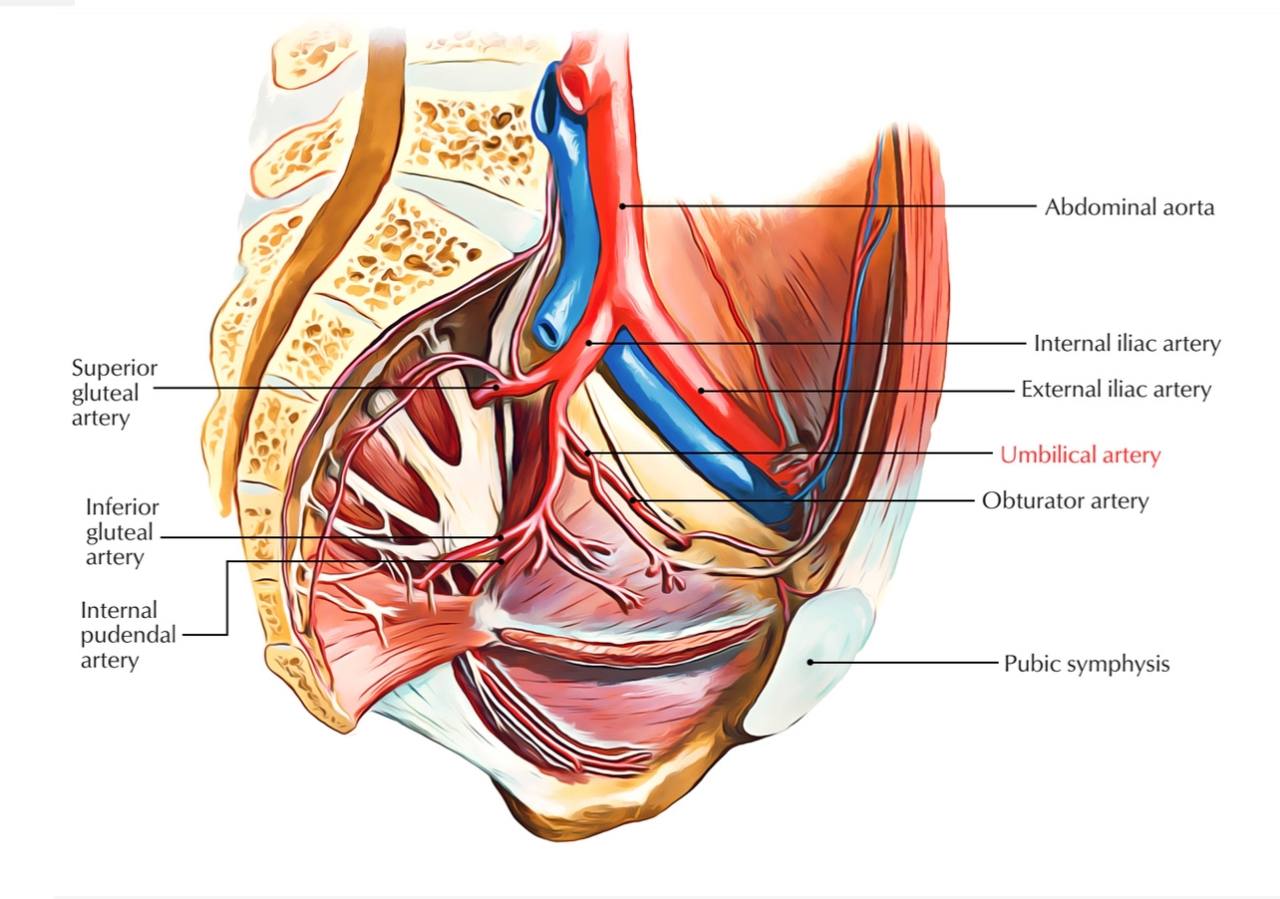
The main function :
. The main functions of the obturator artery are : # /#
1)supplying the muscles in
the pelvis and in the medial (adductor )compartment of the thigh
( obturator externus .. iliacus .. adductor minimus .. adductor longus
.. adductor magnus .. adductor brevis .. pectineus ..and gracilis )..and
psoas muscles .
2)gives a branch to supply the head of the femur .
3)gives a branch to the skin of the medial compartment of the
thigh and ilium bone.
4)gives a branch to the knee joint capsule.
1)supplying the muscles in
the pelvis and in the medial (adductor )compartment of the thigh
( obturator externus .. iliacus .. adductor minimus .. adductor longus
.. adductor magnus .. adductor brevis .. pectineus ..and gracilis )..and
psoas muscles .
2)gives a branch to supply the head of the femur .
3)gives a branch to the skin of the medial compartment of the
thigh and ilium bone.
4)gives a branch to the knee joint capsule.
Course and Relation :
. It originates in the pelvis cavity just below the umbilical artery and passes
anteroinferiorly (forward and downward) on the lateral wall of the pelvis .
. ( the OA
artery )( it is crossed on its medial side by the ureter in both sexes and ducts
deferens in males and in the nulliparous females the ovary lies medial to it.
. to
reach the upper part of the obturator foramen (obturator canal) and passes from
it.
. accompainy with obturator vein and nerve to reach the medial compartment
of the thigh.
. when it passes the obturator canal ..the OA divide into anterior and
posterior branches which pass around the margin of the outer surface of the
obturator membrane and lies within the attachment of the obturator externus
muscle.
anteroinferiorly (forward and downward) on the lateral wall of the pelvis .
. ( the OA
artery )( it is crossed on its medial side by the ureter in both sexes and ducts
deferens in males and in the nulliparous females the ovary lies medial to it.
. to
reach the upper part of the obturator foramen (obturator canal) and passes from
it.
. accompainy with obturator vein and nerve to reach the medial compartment
of the thigh.
. when it passes the obturator canal ..the OA divide into anterior and
posterior branches which pass around the margin of the outer surface of the
obturator membrane and lies within the attachment of the obturator externus
muscle.
Branches :
• Along it course, the obturator artery gives many branches which are
usually grouped as the branches within the pelvic (pelvic branches)and
branches within the thigh (extrapelvic branches)…Branches of the
obturator artery :
• In the pelvis:
1.Pubic branch
2.Iliac branch
3.Vesical branch
. In the thigh:
1.Acetabular branch
2.Anterior branch
3.Posterior branch
. In the pelvic (endopelvic):
.1)Iliac branch : it is a branch to the iliac fossa (part of the pelvic bone
) to supply the iliac bone and supply the iliacus muscle and form
anastomose with the iliolumbar artery.
.2)Vesical artery : it supplies the medial part of the urinary bladder
and sometimes, the vesical artery can be large enough to replace the
inferior vesical artery and supply the vascular territory.
.3)Pubic branch : it arises around the obturator canal ascends upon
the back of the pubis and anastomoses with the pubic branch of the
inferior epigastric artery.
. outside the pelvis (in the thigh):
• The anterior branch : it is a small branch in the thigh ..that curves
downward at the inner margin of the inferior pubic ramus to
anastomose with the posterior branch of the femoral artery and
medial circumflex femoral artery ..it supplies the obturator externus
and hip adductor muscles (adductor logus ..brevis ..magnus ..and
gracillis ..pectineus muscles ..and supplies the skin of the medial
compartment of the thigh.
• The Posterior branch : it is a small artery in the thigh.. it passes
forward on the inferior ramus of the ischium ..it supplies the muscles
that are attached at the ischial tuberosity such as ischiocavernosus
muscle and anastomoses with the inferior gluteal artery.. and gives
the acetabular branch.
. The Acetabular branch : it arises from the posterior branch ...and
enters the hip joint through the acetabular notch and... it is a branch
in the fat at the bottom of the acetabular and sends twigs to the
ligament of the head of the femur (ligament teres)and supplies the
head of the femur… this branch in adults it is small and doesn't have
much importance (but)in children it helps to supply the the head and
neck of the femur (because the epiphyseal line is still made from the
cartilage which does not allow the passage of the blood supply
through it ).
usually grouped as the branches within the pelvic (pelvic branches)and
branches within the thigh (extrapelvic branches)…Branches of the
obturator artery :
• In the pelvis:
1.Pubic branch
2.Iliac branch
3.Vesical branch
. In the thigh:
1.Acetabular branch
2.Anterior branch
3.Posterior branch
. In the pelvic (endopelvic):
.1)Iliac branch : it is a branch to the iliac fossa (part of the pelvic bone
) to supply the iliac bone and supply the iliacus muscle and form
anastomose with the iliolumbar artery.
.2)Vesical artery : it supplies the medial part of the urinary bladder
and sometimes, the vesical artery can be large enough to replace the
inferior vesical artery and supply the vascular territory.
.3)Pubic branch : it arises around the obturator canal ascends upon
the back of the pubis and anastomoses with the pubic branch of the
inferior epigastric artery.
. outside the pelvis (in the thigh):
• The anterior branch : it is a small branch in the thigh ..that curves
downward at the inner margin of the inferior pubic ramus to
anastomose with the posterior branch of the femoral artery and
medial circumflex femoral artery ..it supplies the obturator externus
and hip adductor muscles (adductor logus ..brevis ..magnus ..and
gracillis ..pectineus muscles ..and supplies the skin of the medial
compartment of the thigh.
• The Posterior branch : it is a small artery in the thigh.. it passes
forward on the inferior ramus of the ischium ..it supplies the muscles
that are attached at the ischial tuberosity such as ischiocavernosus
muscle and anastomoses with the inferior gluteal artery.. and gives
the acetabular branch.
. The Acetabular branch : it arises from the posterior branch ...and
enters the hip joint through the acetabular notch and... it is a branch
in the fat at the bottom of the acetabular and sends twigs to the
ligament of the head of the femur (ligament teres)and supplies the
head of the femur… this branch in adults it is small and doesn't have
much importance (but)in children it helps to supply the the head and
neck of the femur (because the epiphyseal line is still made from the
cartilage which does not allow the passage of the blood supply
through it ).
Relation :
. Lateral : obturator fascia.
• Medial : ureter...ductus deferens (in males)...and peritoneum.
• while little below it , there is the obturator nerve.
• Medial : ureter...ductus deferens (in males)...and peritoneum.
• while little below it , there is the obturator nerve.

Variation :
. The obturator artery differs between individuals.
. the difference
may be on one side of the body or on both sides and it may be
unilateral or bilateral on each side.
. The obturator artery shows a single origin or double origin or it arises from
three roots.
• In the variation of the obturator artery ,the OA origin from :
•1)Trunk or posterior division of the internal iliac artery.
•2)External iliac artery as individual or with inferior epigastric branch
•3)Common iliac artery
•4)Inferior gluteal artery
•5)Internal pudendal artery
•6)Inferior epigastric artery
•7)Femoral artery in some case
•8)Superior gluteal artery
•9)Iliolumbar artery
•10)External and internal iliac artery, the OA1 arises from the external
iliac artety, it passes to the superior pubic ramus and before it enters
the obturator canal, it anastomoses with the OA2 which arises from
internal iliac artery.
. the difference
may be on one side of the body or on both sides and it may be
unilateral or bilateral on each side.
. The obturator artery shows a single origin or double origin or it arises from
three roots.
• In the variation of the obturator artery ,the OA origin from :
•1)Trunk or posterior division of the internal iliac artery.
•2)External iliac artery as individual or with inferior epigastric branch
•3)Common iliac artery
•4)Inferior gluteal artery
•5)Internal pudendal artery
•6)Inferior epigastric artery
•7)Femoral artery in some case
•8)Superior gluteal artery
•9)Iliolumbar artery
•10)External and internal iliac artery, the OA1 arises from the external
iliac artety, it passes to the superior pubic ramus and before it enters
the obturator canal, it anastomoses with the OA2 which arises from
internal iliac artery.

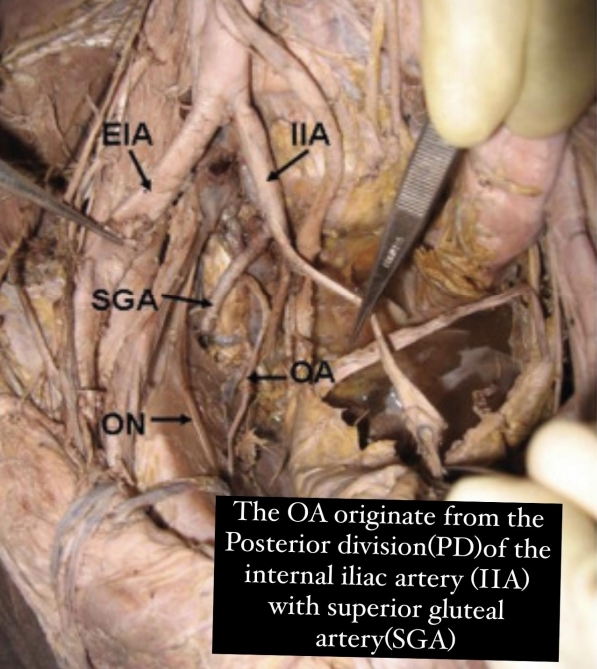


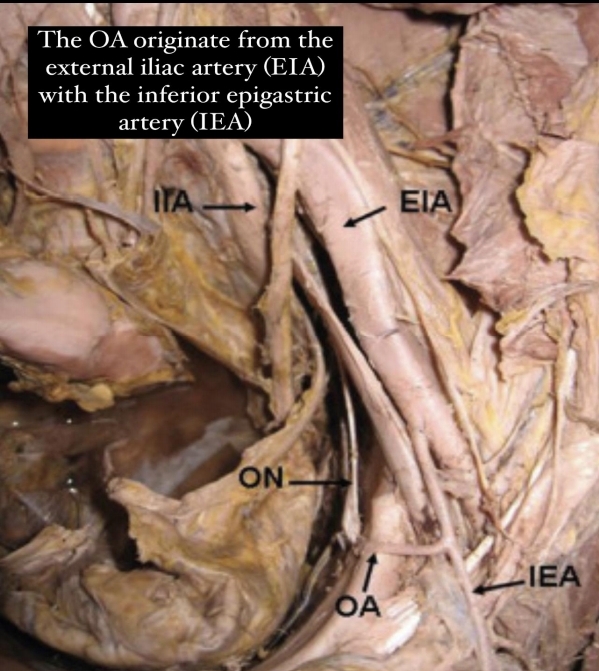
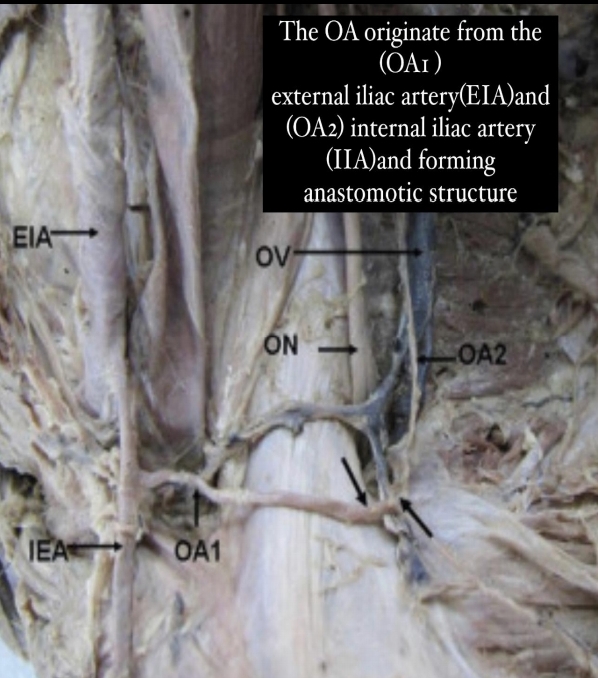

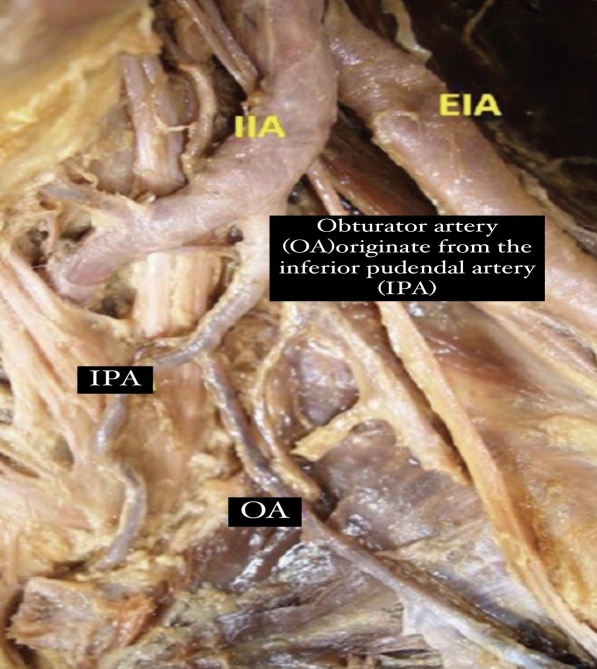
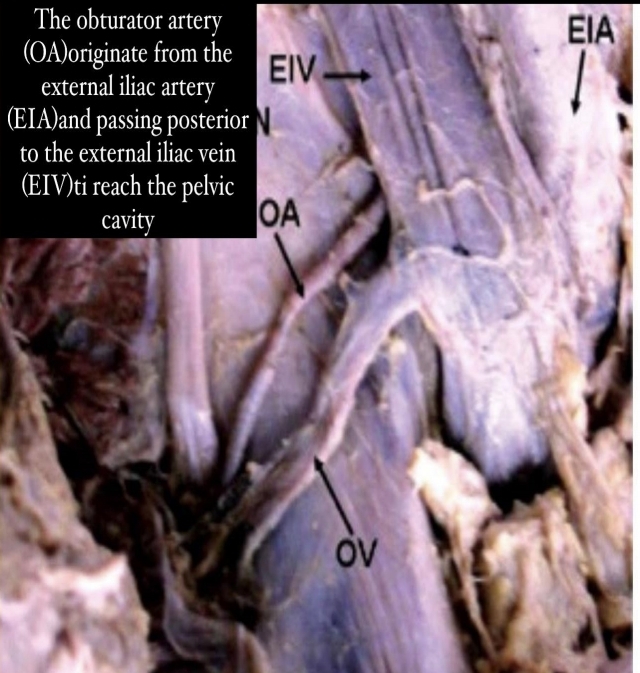

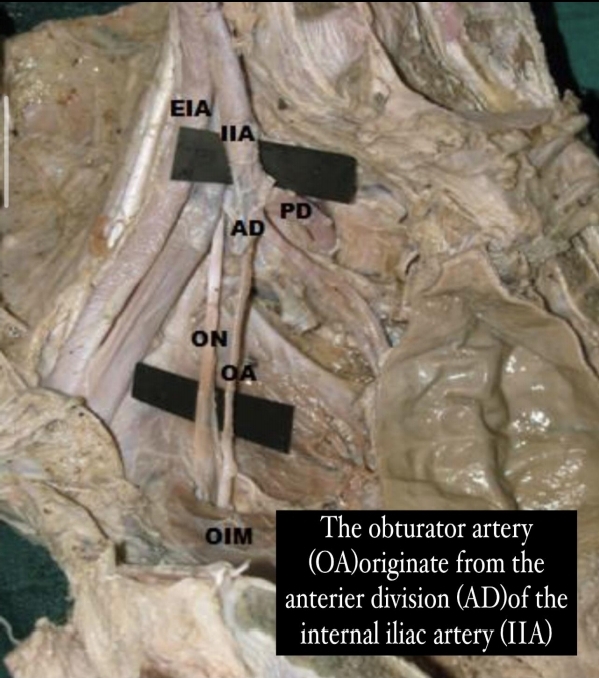


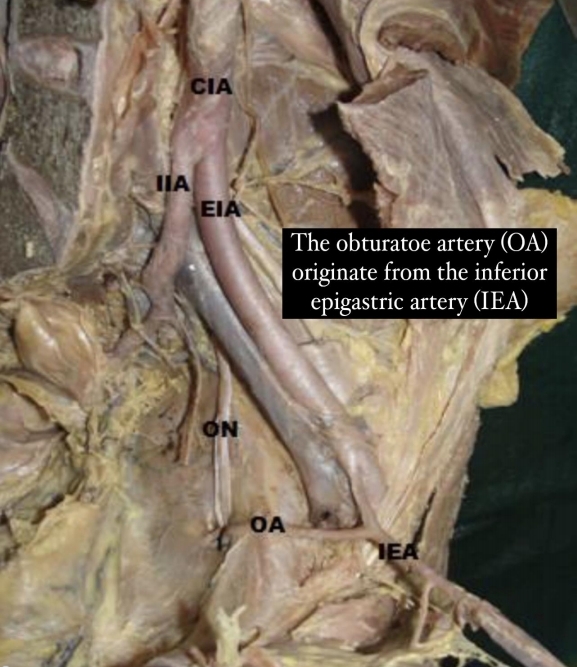
Clinical points :
. Knowing this difference in the obturator artery is important during
gynecological operations, surgery and orthopedics, and surgeons who deal with
direct and indirect hernias need to be aware of this difference because bleeding
may occur that may lead to death during endoscopic inguinal hernia repair and
laparoscopic femoral hernia operations.
. In the 20% of the person:
. the Obturator artery may be replaced by the
enlarge pubic branch of the inferior epigastric artery so the OA
known accessory or replaced obturator artery ... This artery runs
close to or pass through the femoral ring to reach the obturator
foramen and could be closely related to the neck of a femoral
hernia.
. This artery may be the cause of a strangulated femoral
hernia …this condition occurs when the large branch of the inferior
epigastric artery descends into the pelvis along the habitual path of
the pubic branch of the obturator artery…It can be injured during the
femoral hernia repair and thus causes bleeding that is difficult to
control…May lead to death.
. In the 15_17% of people : the obturator artery is adjacent to the
pubic rami(part of the pelvic bone) and can be damaged during the
fraction of the pubic ramus.
gynecological operations, surgery and orthopedics, and surgeons who deal with
direct and indirect hernias need to be aware of this difference because bleeding
may occur that may lead to death during endoscopic inguinal hernia repair and
laparoscopic femoral hernia operations.
. In the 20% of the person:
. the Obturator artery may be replaced by the
enlarge pubic branch of the inferior epigastric artery so the OA
known accessory or replaced obturator artery ... This artery runs
close to or pass through the femoral ring to reach the obturator
foramen and could be closely related to the neck of a femoral
hernia.
. This artery may be the cause of a strangulated femoral
hernia …this condition occurs when the large branch of the inferior
epigastric artery descends into the pelvis along the habitual path of
the pubic branch of the obturator artery…It can be injured during the
femoral hernia repair and thus causes bleeding that is difficult to
control…May lead to death.
. In the 15_17% of people : the obturator artery is adjacent to the
pubic rami(part of the pelvic bone) and can be damaged during the
fraction of the pubic ramus.
Notes :
. The obturator artery that arises from the external iliac artery is called
aberrant obturator artery that crosses the superior pubic rami and is
susceptible to injuries. May cause bleeding that results in serious
complications during the femoral hernia repair or during endoscopy.
. Corona mortis (crown of the death ) it is an anastomosis between the
obturator artery and external iliac artery or inferior epigastric artery
.... It is another source of bleeding when the pelvis is broken or if the
corona is cutten by mistake, dangerous bleeding occurs that may
lead to death, the surgeons must be careful when dissecting near the
superior pubic ramus.... Because of its danger, it is called this name.
aberrant obturator artery that crosses the superior pubic rami and is
susceptible to injuries. May cause bleeding that results in serious
complications during the femoral hernia repair or during endoscopy.
. Corona mortis (crown of the death ) it is an anastomosis between the
obturator artery and external iliac artery or inferior epigastric artery
.... It is another source of bleeding when the pelvis is broken or if the
corona is cutten by mistake, dangerous bleeding occurs that may
lead to death, the surgeons must be careful when dissecting near the
superior pubic ramus.... Because of its danger, it is called this name.
References of images :
Cover image/Obturator artery/kenhub/https://www.kenhub.com/en/library/anatomy/obturator-artery
1)obturator artery/Earth's lab/https://www.earthslab.com/anatomy/internal-iliac-artery/
2)Moore-Clinically Oriented Anatomy (7th Edition) /FIGURE B5.17.
3)The rest of images/Obturator artery /researchgate.net /https://www.researchgate.net/figure/Right-side-of-a-pelvis-showing-the-origin-of-the-obturator-artery-OA-from-the-posterior_fig1_26817536
1)obturator artery/Earth's lab/https://www.earthslab.com/anatomy/internal-iliac-artery/
2)Moore-Clinically Oriented Anatomy (7th Edition) /FIGURE B5.17.
3)The rest of images/Obturator artery /researchgate.net /https://www.researchgate.net/figure/Right-side-of-a-pelvis-showing-the-origin-of-the-obturator-artery-OA-from-the-posterior_fig1_26817536
